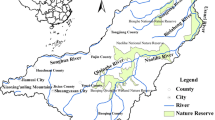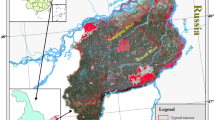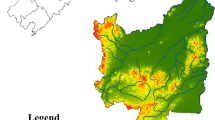Abstract
Marshes in the Sanjiang Plain of Northeast China have undergone dramatic loss and fragmentation over the past decades. This paper analyzed the loss and fragmentation of these marshes for the period 1954–2005 using historical land-cover information and remote sensing data. In 1954, marshes covered one-third of the total land area but have decreased by 77% over the 50 year period. Results showed two distinct periods of impact: 1954–1986 and 1987–2005. In the earlier period, the number of marsh patches fell from 4,799 to 1,476 (−69.2%), and total marsh area decreased from 35,270 km2 to 13,893 km2 (−60.6%). In the latter period, the number of marshes declined from 1,476 to 1,037 (−29.7%), and the total area decreased from 13,893 km2 to 8,100 km2 (−41.7%). The rapid decrease in the number and area of marshes during 1954–1986 was largely attributed to extensive agricultural reclamation under the “Food First” agricultural policy. This resulted in many negative ecological consequences. In contrast, the slower reduction of marsh areas during 1987–2005 was due to the implementation of governmental policies for protecting and restoring marshes. Increasing air temperature would otherwise have enhanced crop yields and stimulated the conversion of marsh into crops.




Similar content being viewed by others
References
Acharya G (2000) Approaches to valuing the hidden hydrological services of wetland ecosystems. Ecological Economics 35:63–74
Allen RG, Pereira LS, Raes D, Smith M (1998) Crop evapotranspiration-Guidelines for computing crop water requirements. FAO Irrigation and Drainage Paper 56, Rome, Italy
An S, Li H, Guan B, Zhou C, Wang Z, Deng Z, Zhi Y, Liu Y, Xu C, Fang S, Jiang J, Li H (2007) China’s natural wetlands: past problems, current status, and future challenges. Ambio 36:335–342
Balmford A, Bruner A, Copper P, Costanza R, Farber S, Green RE, Jenkins M, Jefferiss P, Jessamy V, Madden J, Munro K, Myers N, Naeem S, Paavola J, Rayment M, Rosendo S, Roughgarden J, Trumper K, Kerry-Tuner R (2002) Economic reasons for conserving wild nature. Science 297:950–953
Brinson MM, Malvárez AA (2002) Temperate freshwater wetlands: types, status, and threats. Environmental Conservation 29:115–133
Coveney MF, Stites DL, Lowe EF, Battoe LE, Conrow R (2002) Nutrient removal from eutrophic lake water by wetland filtration. Ecological Engineering 19:141–159
Cui BS, Liu XT (1999) Changes of ecological characteristics and sustainable management of wetlands in Sanjiang Plain. Regional Research and Development 18:45–48 (in Chinese)
Cushman SA (2005) Effects of habitat loss and fragmentation on amphibians: a review and prospectus. Biological Conservation 128:231–240
Detenbeck NE, Galatowitsch SM, Atkinson J, Ball H (1999) Evaluating perturbations and developing restoration strategies for inland wetlands in the Great Lakes Basin. Wetlands 19:789–820
Erwin KL (2009) Wetlands and global climate change: the role of wetland restoration in a changing world. Wetlands Ecology and Management 17:71–84
Finlayson CM, Rea N (1999) Reasons for the loss and degradation of Australian wetlands. Wetlands Ecology and Management 7:1–11
He L (2000) China’s Sanjiang Plain. Science and Technology Press of Heilongjiang Province, Harbin (in Chinese)
Herold M, Goldstein NC, Clarke KC (2003) The spatiotemporal form of urban growth: measurement, analysis and modeling. Remote Sensing of Environment 86:286–302
Holland CC, Honea J, Gwin SE, Kentula ME (1995) Wetland degradation and loss in the rapidly urbanizing area of Portland, Oregon. Wetlands 15:336–345
Hou W, Zhang SW, Zhang YZ, Kuang WH (2004) Analysis on the shrinkage process of wetland in Naoli River Basin of Sanjiang Plain since the 1950s and its driving forces. Journal of Natural Resources 19:725–731 (in Chinese)
Huang Y, Sun WJ, Zhang W, Yu YQ, Su YH, Song CC (2009) Marshland conversion to cropland in northeast China from 1950 to 2000 reduced the greenhouse effect. Global Change Biology 16:680–695
Keller JK, White JR, Bridgham SD, Pastor J (2004) Climate change effects on carbon and nitrogen mineralization in peatlands through changes in soil quality. Global Change Biology 10:1053–1064
Kingsford RT (2000) Ecological impacts of dams, water diversions and river management on floodplain wetlands in Australia. Austral Ecology 25:109–127
Lee SY, Dunn JK, Young RA, Connolly RM, Dale PER, Dehayr R, Lemckert CJ, Mckinnon S, Powell B, Teasdale PR, Welsh DT (2006) Impact of urbanization on coastal wetland structure and function. Austral Ecology 31:149–163
Li Y, Zhang YZ, Zhang SW (2002) Landscape pattern and ecological effect of the marsh changes in the Sanjiang Plain. Scientia Geographica Sinica 22:677–682 (in Chinese)
Li X, Wang Z, Song K, Zhang B, Liu D, Guo Z (2007) Assessment for salinized wasteland expansion and land use change using GIS and remote sensing in the west part of Northeast China. Environmental Monitoring and Assessment 131:421–437
Liu XT (2007) Water storage and flood regulation function of marshes in the Sanjiang Plain. Wetland Science 5(1):64–68 (in Chinese)
Liu XT, Ma XH (2000) Effects of large-scale reclamation on environments and regional environment protection in Sanjiang Plain. Scientia Geographica Sinica 20:14–19 (in Chinese)
Liu XT, Ma XH (2002) Natural environmental changes and ecological protection in Sanjiang Plain. Science, Beijing (in Chinese)
Liu HY, Zhang SK, Li ZF, Lu XG, Yang Q (2004) Impacts on wetlands of large-scale land-use changes by agricultural development: the small Sanjiang Plain, China. Ambio 33:306–310
Liu GH, Zhou J, Li W, Cheng Y (2005a) The seed bank in a subtrophical freshwater marsh: implications for wetland restoration. Aquatic Botany 81:1–11
Liu YS, Wang DW, Gao J, Deng W (2005b) Land use/cover changes, the environment and water resources in Northeast China. Environmental Management 36:691–701
Liu HY, Li ZF, Li XM (2007) Effects of wetland landscape fragmentation on habitats of Oriental stork-a case study in Northeastern part of Sanjiang Plain. Journal of Natural Resources 22:817–823 (in Chinese)
Maltby E (1991) Wetland management goals: wise use and conservation. Landscape and Urban Planning 20(1–3):9–18
McGarigal K, Marks B (1995) FRAGSTATS: Spatial analysis program for quantifying landscape structure. General Technical Report PNW-GTR-351. U.S. Department of Agriculture, Forest Service, Pacific Northwest Research Station, Portland, USA
Millennium Ecosystem Assessment (2005) Ecosystems and human well-being: Wetlands and water synthesis. Island, Washington DC
Milly PCD (1994) Climate, soil water storage, and the average annual water balance. Water Resources Research 30:2143–2156
Mitsch WJ, Gosselink JG (2007) Wetlands, 4th edn. Wiley, New York
Moiwo JP, Lu WX, Zhao YS, Yang YH, Yang YM (2010) Impact of land use on distributed hydrological processes in the semi-arid wetland ecosystem of Western Jilin. Hydrological Process 24:492–503
Na SH, Zhang J (2004) Ecological restoration of wetlands in Sanjiang Plain. Journal of Northeast Forestry University 32:78–80 (in Chinese)
NBSC (National Bureau of Statistics of China) (1999) 50 years of Heilongjiang Province. China Statistical Publishing House, Beijing (in Chinese)
NBSC (National Bureau of Statistics of China) (2001–2006) Heilongijang Statistical Yearbook 2000–2005. China Statistical Publishing House, Beijing, China (in Chinese)
Nicholls RJ (2004) Coastal flooding and wetland loss in the 21st century: changes under the SRES climate and socio-economic scenarios. Global Environmental Change 14:69–86
Nyman JA, Carloss M, Delaune RD, Patrick WH (1994) Erosion rather than plant dieback as the mechanism of marsh loss in an estuarine marsh. Earth Surface Processes and Landforms 19(1):69–84
Song KS, Liu DW, Wang ZM, Zhang B, Jin C, Li F, Liu HJ (2008) Land use change in Sanjiang Plain and its driving forces analysis since 1954. Acta Geographica Sinica 63(1):93–104 (in Chinese)
The Ramsar Convention on Wetlands (2009) The annotated ramsar list: China. http://www.ramsar.org/profiles_China.htm
Turner RE, Yeleswarapu SR (1990) Relationships between wetland fragmentation and recent hydrologic change in a deltaic coast. Estuaries 13:272–281
Turner RK, van den Bergh KCJM, Söderqvist T, Barendregt A, van der Straaten J, Maltby E, van Ierland EC (2000) Ecological-economic analysis of wetlands: scientific integration for management and policy. Ecological Economics 35:7–23
United States Environmental Protection Agency (2009) Marshes. http://water.epa.gov/type/wetlands/marsh.cfm.
Wang ZM, Zhang B, Zhang SQ (2005) Estimates of loss in ecosystem service values of Songnen Plain from 1980 to 2000. Journal of Geographical Sciences 15:80–86
Wang ZM, Zhang B, Zhang SQ, Li XY, Liu DW, Song KS, Li JP, Li F, Duan HT (2006) Changes of land use and of ecosystem service values in Sanjiang Plain, Northeast China. Environmental Monitoring and Assessment 112:69–91
Wang ZM, Song KS, Liu DW, Zhang B, Zhang SQ, Li F, Ren CY, Jin C, Yang T, Zhang CH (2009a) Process of land conversion from wetland into cropland and driving forces in Sanjiang Plain. Wetland Science 7:208–217 (in Chinese)
Wang ZM, Song KS, Zhang B, Liu D, Ren C, Luo L, Yang T, Huang N, Hu L, Yang H, Liu Z (2009b) Shrinkage and fragmentation of grasslands in the West Songnen Plain, China. Agriculture, Ecosystems and Environment 129:315–324
Wolock DM, McCabe GJ (1999) Explaining spatial variability in mean annual runoff in the conterminous United States. Climate Research 11:149–159
Yan Z, Wu N (2005) Rangeland privatization and its impact on the Zoige wetlands on the Eastern Tibetan Plateau. Journal of Mountain Science 2:105–115
Ying X, Wang K (2010) Eco-compensation effects of the wetland recovery in Dongting Lake area. Journal of Geographical Sciences 20:389–405
Zhang SQ, Na XD, Kong B, Wang ZM, Jiang HX, Yu H, Zhao ZC, Li XF, Liu CY, Dale P (2009) Identifying wetland change in China’s Sanjiaing Plain using remote sensing. Wetlands 29:302–313
Zhang J, Ma K, Fu B (2010) Wetland loss under impact of agricultural development in the Sanjiang Plain, NE China. Environmental Monitoring and Assessment 166:139–148
Zheng SF, Zhang B, Wang ZM, Zhang SQ (2008) Landscape pattern changes of Fuyuan County in the Sanjiang Plain. Wetland Science 6:13–18 (in Chinese)
Acknowledgments
This research was supported by the Strategic Frontier Program of Chinese Academy of Sciences (No. XDA05050101), the National Basic Research Program of China (No. 2009CB421103), the Knowledge Innovation Program of Chinese Academy of Sciences (No. KZCX2-YW-341), and the National Natural Science Foundation of China (No. 40930527). We thank the editor in chief, associate editor, and two anonymous reviewers for help that greatly improved the manuscript.
Author information
Authors and Affiliations
Corresponding author
Rights and permissions
About this article
Cite this article
Wang, Z., Song, K., Ma, W. et al. Loss and Fragmentation of Marshes in the Sanjiang Plain, Northeast China, 1954–2005. Wetlands 31, 945–954 (2011). https://doi.org/10.1007/s13157-011-0209-0
Received:
Accepted:
Published:
Issue Date:
DOI: https://doi.org/10.1007/s13157-011-0209-0




